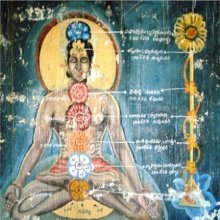Siddhasana, Siddha-asana, Siddhāsana: 10 definitions
Introduction:
Siddhasana means something in Hinduism, Sanskrit, Hindi. If you want to know the exact meaning, history, etymology or English translation of this term then check out the descriptions on this page. Add your comment or reference to a book if you want to contribute to this summary article.
Alternative spellings of this word include Siddhasan.
Images (photo gallery)
In Hinduism
Yoga (school of philosophy)
Source: Wisdom Library: YogaSiddhāsana (सिद्धासन) is one of the eighty-four āsanas (postures) taught by Śiva, according to the Haṭharatnāvalī 3.7-20. It is said that Ādinātha (Śiva) hand-picked 84 yoga postures from 84,00,000 living beings and taught them for the purpose of introducing physical health and well-being to the human body. The compound siddhāsana consists of the words siddha (accomplished) and āsana (posture).
The 17th-century Haṭharatnāvalī is a Sanskrit reference book dealing with these āsanas (e.g., siddhāsana) which form a major constituent of the haṭhayoga practice. It was written by Śrīnivāsa.
Source: Google Books: The Hatha Yoga PradipikaSiddhāsana (सिद्धासन) refers to an āsana (posture) taught by Śiva. It is one of the first four out of 84 total, thus one of the most essential, according to Haṭhayogapradīpikā I.37-45.—Accordingly, “Press firmly the heel of the left foot against the perineum, and the right heel above the male organ. With the chin pressing on the chest, one should sit calmly, having restrained the senses, and gaze steadily the space between the eyebrows. This is called the siddhāsana, the opener of the door of salvation”.
Also, “This siddhāsana is performed also by placing the left heel on Meḍhra (above the male organ), and then placing the right one on it. Some call this siddhāsana, some vajrāsana. Others call it muktāsana or guptāsana. Out of the 84 āsanas, siddhāsana should always be practised, because it cleanses the impurities of 72,000 nāḍīs”.
The 15th-century Haṭhayogapradīpikā by Svātmārāma is one of the oldest extant texts dealing with haṭhayoga: an ancient form of meditation founded by Matsyendranātha. The first chapter of this book describes various āsanas (e.g., siddha-āsana).
Source: archive.org: Yoga Tradition of the Mysore PalaceSiddhāsana (सिद्धासन) is a type of standing posture (āsana), according to verse 80 of the Śrītattvanidhi.—Accordingly, “Place the left ankle below the penis and the right above it. Maintain balance and look at the space between the eyebrows. This is siddhāsana, the āsana of accomplishment”.
The 19th-century Śrītattvanidhi is a sanskrit treatise describing 80 primary āsanas, or ‘posture’ (e.g., siddha-āsana) and several additional ones.
Note: this āsana is listed in many places.
Source: archive.org: Gheranda SamhitaSiddhāsana (सिद्धासन) is one of the thirty-two āsanas (postures) taught in the second chapter of the Gheraṇḍasaṃhitā: “the perineal region with one heel placed against it, resting the other ankle above the penis, placing the chin on the chest, (remaining) motionless with Indriyas (senses) under control, and gazedirected towards the middle of the eye brows. This is called Siddhāsana (which) breaks open the door to Liberation”.
Siddhāsana is one of the selected 32 postures amongs 8,400,000 total mentioned by Śiva, according to Gheraṇḍasaṃhitā 2.1-2, “In all, there are as many Āsanas as species of animals. Eighty-four lacs of them are mentioned by Śiva. Out of them, 84 are regarded as important and among these 84, again 32 are good (enough) in this world of mortal beings”.
The 17th-century Gheraṇḍasaṃhitā (mentioning siddha-āsana) is one of the three classic texts of Haṭha-yoga: a major branch of Yoga, sharing similarities with the Yoga system taught by Patañjali, though claiming its own mythical founder known as Matsyendranātha. This gheraṇḍa-saṃhitā is an encyclopedic Sanskrit treatise describing thirty two such āsanas.

Yoga is originally considered a branch of Hindu philosophy (astika), but both ancient and modern Yoga combine the physical, mental and spiritual. Yoga teaches various physical techniques also known as āsanas (postures), used for various purposes (eg., meditation, contemplation, relaxation).
Languages of India and abroad
Sanskrit dictionary
Source: DDSA: The practical Sanskrit-English dictionarySiddhāsana (सिद्धासन).—a particular posture in religious meditation.
Derivable forms: siddhāsanam (सिद्धासनम्).
Siddhāsana is a Sanskrit compound consisting of the terms siddha and āsana (आसन).
Source: Cologne Digital Sanskrit Dictionaries: Shabda-Sagara Sanskrit-English DictionarySiddhāsana (सिद्धासन).—n.
(-naṃ) A particular posture in religious meditation.
Source: Cologne Digital Sanskrit Dictionaries: Monier-Williams Sanskrit-English Dictionary1) Siddhāsana (सिद्धासन):—[from siddha > sidh] n. a [particular] sedent posture in religious meditation (described as placing the left heel under the body and the right heel in front of it, fixing the sight between the eyebrows, and meditating upon the syllable om), [Catalogue(s)]
2) [v.s. ...] m. Name of Skanda, [cf. Lexicographers, esp. such as amarasiṃha, halāyudha, hemacandra, etc.]
[Sanskrit to German]
Sanskrit, also spelled संस्कृतम् (saṃskṛtam), is an ancient language of India commonly seen as the grandmother of the Indo-European language family (even English!). Closely allied with Prakrit and Pali, Sanskrit is more exhaustive in both grammar and terms and has the most extensive collection of literature in the world, greatly surpassing its sister-languages Greek and Latin.
Hindi dictionary
Source: DDSA: A practical Hindi-English dictionarySiddhāsana (सिद्धासन) [Also spelled siddhasan]:—(nm) a typical sitting posture.
...
Kannada-English dictionary
Source: Alar: Kannada-English corpusSiddhāsana (ಸಿದ್ಧಾಸನ):—[noun] a meditation posture of squatting with cross legs, keeping the back vertically straight and both hands stretched to sit on the knees of respective side.
Kannada is a Dravidian language (as opposed to the Indo-European language family) mainly spoken in the southwestern region of India.
See also (Relevant definitions)
Partial matches: Siddha, Asana.
Ends with: Parivrittasiddhasana, Sadhyasiddhasana.
Relevant text
Search found 12 books and stories containing Siddhasana, Siddha-asana, Siddhāsana, Siddha-āsana; (plurals include: Siddhasanas, asanas, Siddhāsanas, āsanas). You can also click to the full overview containing English textual excerpts. Below are direct links for the most relevant articles:
Puranic encyclopaedia (by Vettam Mani)
Varahi Tantra (English Study) (by Roberta Pamio)
Chapter 26 - Haṭhayoga (according to the Haṭhayogapradīpikā) < [Summary of the Vārāhī Tantra]
Yoga-sutras (with Bhoja’s Rajamartanda) (by Rajendralala Mitra)
Sūtra 2.46 < [Second Chapter (Sadhana Pada)]
Lakulisha-Pashupata (Philosophy and Practice) (by Geetika Kaw Kher)
Samkaracarya and Kapalikas < [Chapter 2 - Spread and Transition]
Shat-cakra-nirupana (the six bodily centres) (by Arthur Avalon)
Verse 36 < [Section 6]



